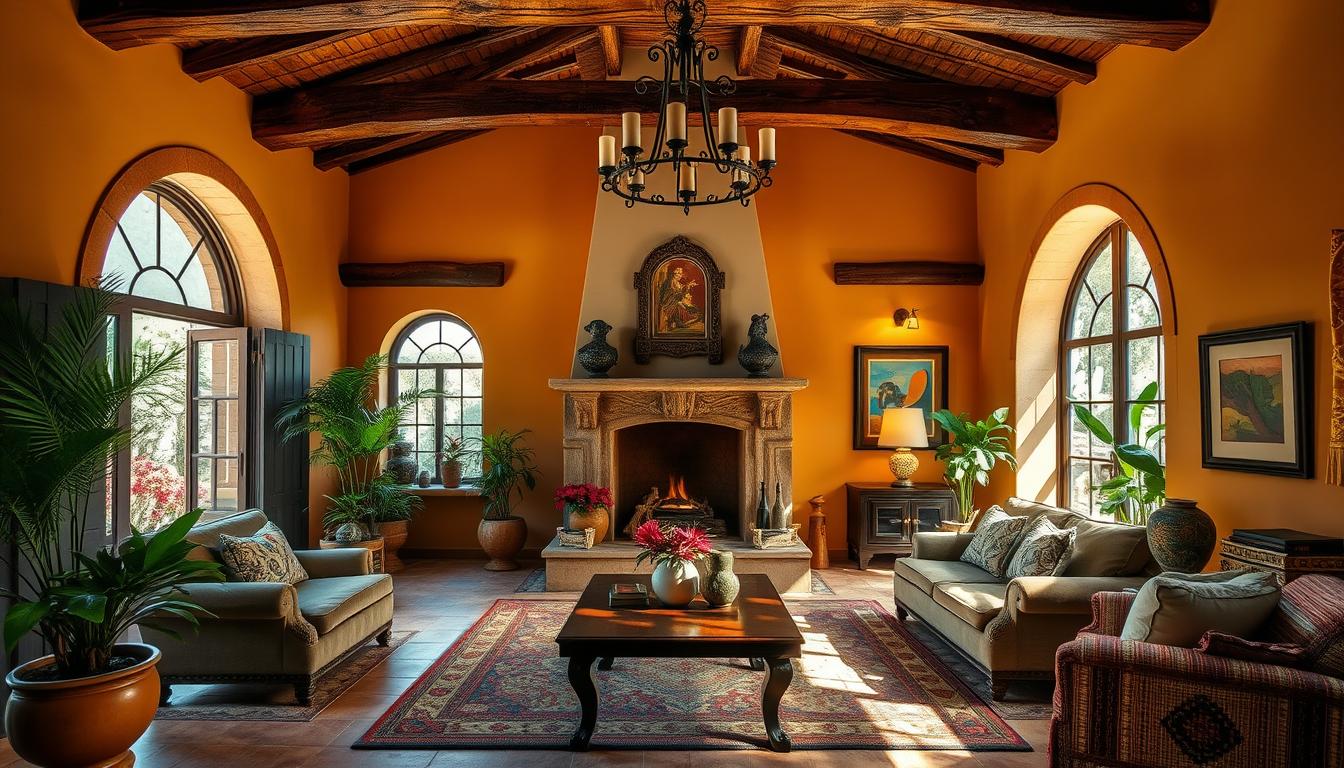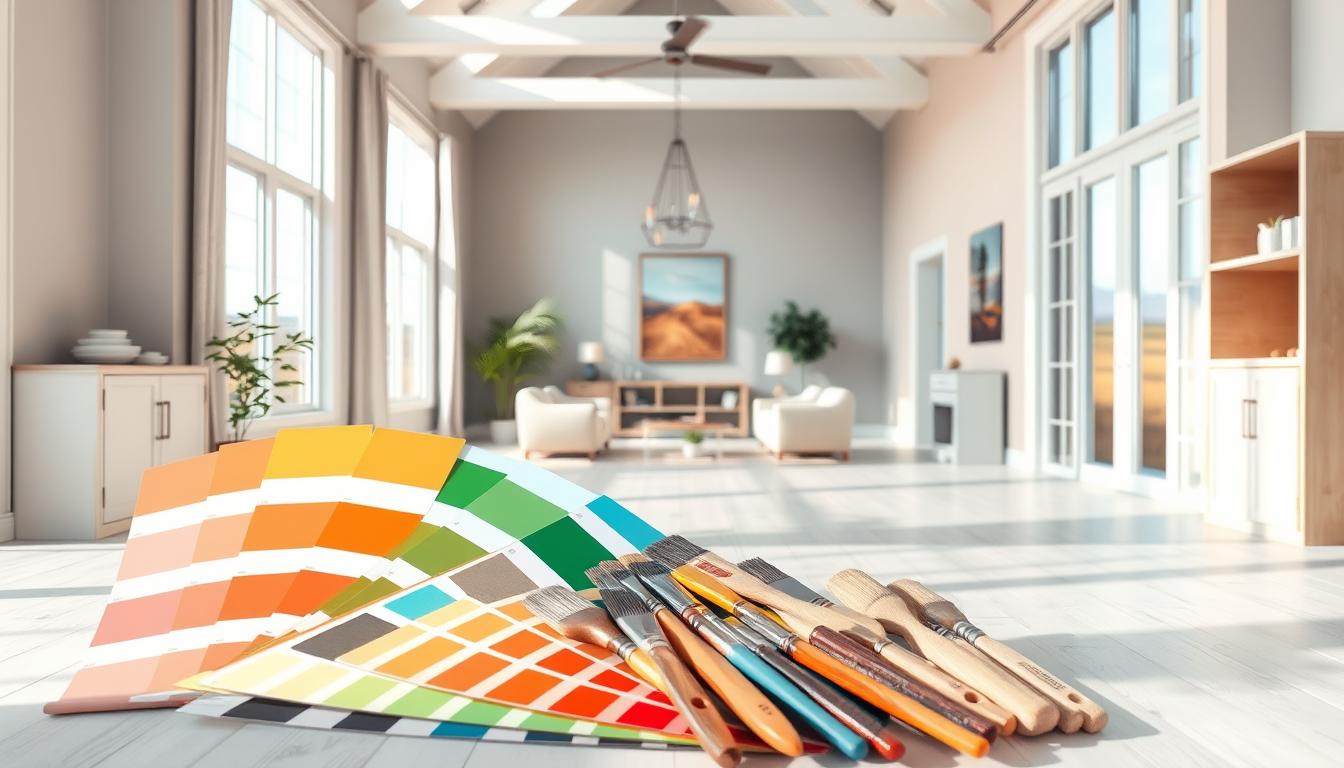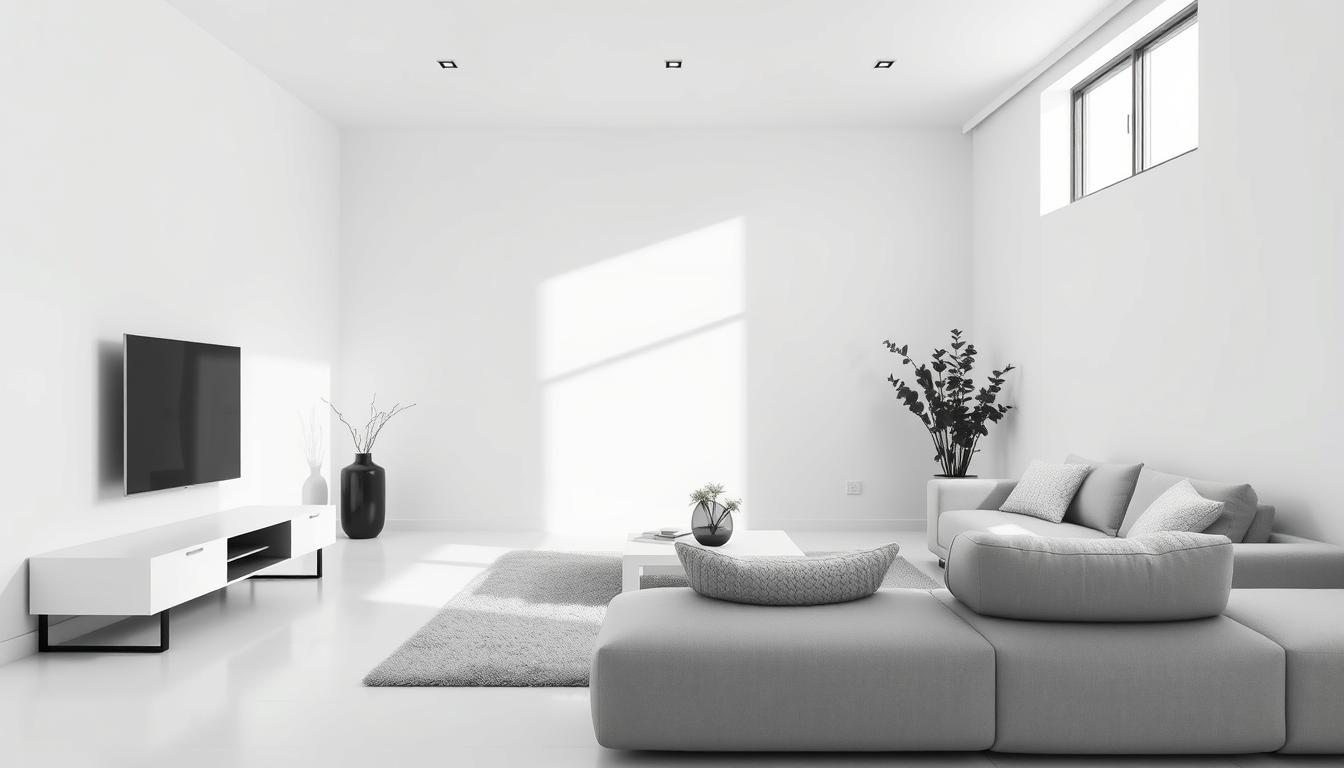Did you know homes with a warm feel can be worth up to 15% more? To get this look, add Spanish-style interior design elements. These include rich textures, bright colors, and detailed designs.
We can make our homes better by using Spanish architecture and Mediterranean styles. This mix of rustic wood, detailed tiles, and fancy metalwork makes a space both fancy and snug.
Key Takeaways
- Create a warm atmosphere with rich textures and vibrant colors.
- Incorporate rustic wood and ornate metalwork for a unique look.
- Use intricate tile work to add visual interest.
- Balance elegance and coziness in your home design.
- Draw inspiration from Spanish architecture and the Mediterranean region.
Understanding Spanish Style Homes and Their Origins
Spanish-style homes started in the early 20th century. They are known for their warm look and deep history. This style is a big part of Mediterranean decor.
Spanish homes were shaped by many cultures, like the Moors and Romans. Their designs show a mix of these cultures. This mix makes Spanish homes both beautiful and practical.
Historical Influences on Spanish Architecture
Spanish architecture has been shaped by many times, from the Islamic Golden Age to the Renaissance. These periods added special features like arches and intricate tile work.
Key Elements of Spanish Design
Spanish design uses natural materials like wood, stone, and clay. These materials make spaces feel warm and textured. Also, Spanish homes often have ornate details like carved wood and decorative tiles. These add a touch of luxury and grandeur.
The Warmth of Spanish Homes
Spanish homes are warm because of their design and materials. They often use earthy colors like terracotta and sienna. These colors make the homes feel cozy and welcoming. Textiles like wool and linen also add to the warmth and comfort of these homes.
In summary, Spanish-style homes reflect the country’s rich culture and architecture. By knowing the history and key elements of Spanish design, homeowners can create spaces that are both stunning and warm.
Signature Colors in Spanish Interior Design
Spanish interior design is all about vibrant and earthy colors. These colors take you straight to Spain’s warm landscapes. It’s known for earthy tones and vibrant accents, making spaces inviting and true to their roots.
Earthy Tones and Vibrant Accents
Spanish design often uses earthy colors like terracotta reds and soft ochres. These colors remind us of the Spanish countryside. Then, vibrant colors like turquoise and cobalt blue add a splash of color.
This mix of earthy and bright colors makes Spanish-style homes stand out. For example, terracotta tiles with cobalt blue pieces bring a rustic charm to spanish architecture.
| Color | Description | Common Use |
|---|---|---|
| Terracotta Red | Warm, earthy tone | Floor tiles, decorative pots |
| Cobalt Blue | Vibrant, deep blue | Decorative tiles, accent pieces |
| Ochre | Soft, yellowish-brown | Walls, furniture |
Utilizing Neutrals to Enhance Spaces
Neutral colors are key in Spanish design. They provide a calm background for earthy and bright colors to shine. Beige, cream, and soft gray are favorites for balance and harmony.
Using neutrals makes spaces feel bigger and more peaceful. This is perfect for rustic home decor, focusing on natural materials and earthy colors.
How Light Affects Color Choices
Light is very important in Spanish design. It changes how we see colors. Natural light warms earthy tones, while artificial light highlights bright colors.
In places with little natural light, choose colors that don’t make it feel dark. Lighter shades can make a space feel brighter and more welcoming.
Textures That Define Spanish Interiors
Spanish interiors are known for their rich textures. These textures add warmth and character to a home. The use of different textures makes a house feel cozy and inviting.
The Role of Stucco and Adobe
Stucco and adobe are key textures in Spanish interiors. They bring history and tradition to the walls. Stucco has a smooth, slightly rough finish. It helps blend indoors and outdoors smoothly.
Adobe adds a warm, earthy tone to the interior. It makes the space feel cozy and welcoming.
Adding Warmth with Wood Beams
Wood beams are essential in Spanish interiors. They add warmth and coziness to ceilings and walls. The natural grain of the wood creates a welcoming ambiance.
Wood beams work well in both traditional and modern designs. They make any space feel more intimate and comfortable.
Incorporating Textiles for Comfort
Textiles are vital in enhancing comfort and warmth in Spanish interiors. Plush rugs and intricately woven tapestries add a tactile dimension. Spanish tile patterns are also used to create vibrant designs.
These designs add visual interest to floors and walls. By using various textiles, homeowners can create a layered, inviting atmosphere. This atmosphere reflects the warmth and hospitality of Spanish culture.
Furniture Styles Commonly Found in Spanish Homes
Spanish homes are known for their rustic, handcrafted furniture. This adds warmth and character to any room. They blend traditional and modern styles, creating a unique look that’s both inviting and elegant.
Rustic Spanish Furniture Aesthetics
Rustic Spanish furniture uses natural materials like wood and iron. It focuses on craftsmanship. Pieces often have intricate carvings, ornate details, and a distressed finish, giving them a vintage look.
- Use of natural materials like wood and iron
- Intricate carvings and ornate details
- Distressed finishes to give a worn look
- Emphasis on craftsmanship and handmade pieces
Importance of Handcrafted Pieces
Handcrafted furniture is highly valued in Spanish interior design. It adds a unique character and a human touch to a room. Each piece shows the skill and craftsmanship of the artisan who made it.
Some benefits of handcrafted pieces in your Spanish-style home include:
| Benefit | Description |
|---|---|
| Unique Character | Handcrafted pieces add a unique touch to your home, making it stand out from mass-produced furniture. |
| Craftsmanship | Each handcrafted piece is a testament to the skill and craftsmanship of the artisan. |
| Quality | Handcrafted furniture is often made with higher quality materials and construction methods. |
Mixing Modern and Traditional Elements
While traditional Spanish furniture has a rustic charm, modern elements can add a fresh look. Mixing both styles allows homeowners to personalize their space while keeping the essence of Spanish style.
Some tips for mixing modern and traditional elements include:
- Pairing a traditional wooden table with modern chairs
- Incorporating modern lighting fixtures into a traditional space
- Using modern textiles, such as throw pillows and blankets, to add color and texture to a traditional room
By combining traditional Spanish furniture with modern design, homeowners can create a unique and inviting space. This space reflects their personal style.
Lighting Solutions for Spanish-Inspired Spaces
Elegant Spanish interiors often have lighting that’s both useful and beautiful. Lighting is key in making these homes feel warm and welcoming. We’ll look at different lighting options to help you create a Spanish-inspired space.
Statement Fixtures: Chandeliers and Lanterns
Chandeliers and lanterns are big in Spanish design. They light up the room and add beauty. Chandeliers with intricate metalwork or wrought iron are favorites for their elegance.
Lanterns, hung or on tables, add warmth and coziness. They come in many styles, from traditional to modern, fitting well in Spanish homes.
Natural Light and Window Treatments
Natural light is vital in Spanish architecture and design. Big windows and doors connect indoors to outdoors, letting in lots of light. This makes spaces feel open and connected.
Window treatments in Spanish homes often include drapes made from heavy, rich fabrics. These drapes control light and add luxury to the room.
Layering Light Throughout the Room
Layering light makes a space interesting and functional. In Spanish homes, this means using different lights like overhead, table, and floor lamps. Using a mix of light sources creates a cozy and inviting atmosphere.
In a living room, start with a chandelier or pendant light. Then add table lamps or sconces for warm light pools. This layering improves the mood and lets you adjust the light.
Incorporating Tile Work in Interior Design
Tile work, like mosaic and decorative tiles, is key in Spanish interior design. These tiles bring vibrant colors and intricate designs. They can turn any room into a Mediterranean gem.
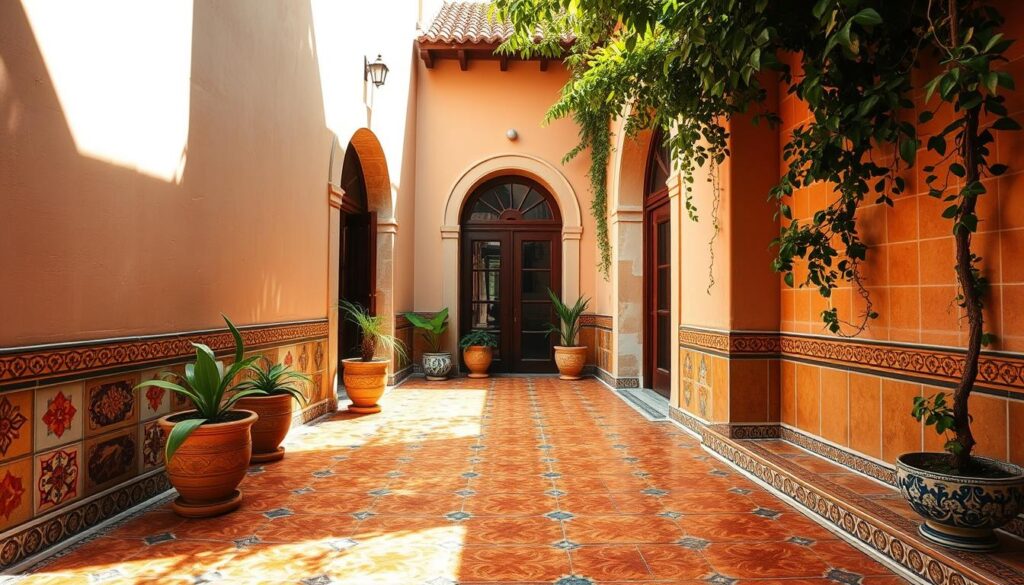
The Art of Mosaic and Decorative Tiles
Mosaic tiles are a must in Spanish design. They create stunning visuals. You can use them for backsplashes, wall art, or to highlight furniture.
When picking mosaic tiles, think about the colors and patterns. Vibrant blues and yellows can brighten up a space. Earthy tones can make it more calm.
Choosing the Right Tile for Each Space
The right tile depends on the room’s use and look you want. For busy places like kitchens and bathrooms, durable, easy-to-clean tiles are best.
Here’s a look at tile types for different rooms:
| Room | Recommended Tile Type | Design Consideration |
|---|---|---|
| Kitchen | Glazed Ceramic or Porcelain | Easy to clean, resistant to stains |
| Bathroom | Mosaic or Glass Tiles | Water-resistant, visually appealing |
| Living Room | Decorative Ceramic or Terracotta | Aesthetic appeal, can be used for accent walls |
Mixing and Matching Patterns
Working with tiles lets you mix patterns for a unique look. It’s important to keep a consistent color scheme to avoid too much.
Start with a main pattern and add accent tiles. For example, a geometric pattern with solid-colored tiles can balance well.
By carefully choosing tile work, you can add depth and Spanish flair to your home.
Landscaping Ideas for Spanish-Style Homes
Spanish-style homes are beautiful inside and out. Their outdoor landscapes are key to their charm. Good landscaping makes these homes even more stunning.
Traditional Courtyards and Gardens
Traditional Spanish courtyards and gardens add to the home’s beauty. They are peaceful and welcoming. You’ll find:
- Central fountains or water features
- Lush greenery and vibrant flowers
- Ornate tile work and decorative elements
- Comfortable seating areas
To make a traditional courtyard, use these elements. Focus on symmetry and balance.
Incorporating Water Features
Water features are a big part of Spanish landscaping. They bring calm to the outdoor space. You can choose from:
- Fountains: simple or elaborate
- Ponds: with a small fountain or waterfall
- Small pools: great for cooling off
Adding a water feature can make the space feel more peaceful.
Colorful Plant Options for Authenticity
Choosing the right plants is important for a Spanish-style garden. Pick plants native to Spain or common in Spanish gardens, like:
- Oleander
- Lavender
- Bougainvillea
- Rosemary
These plants add color and scent. They help create a true Spanish feel.
Creating an Inviting Entryway
The entryway is the first thing people see when they enter your home. With Spanish-style design, it’s a chance to make a lasting impression. A well-designed entryway welcomes guests and shows the warmth and elegance of Spanish-style homes.
Spanish-Style Doors that Impress
The front door is key in the entryway. In Spanish-style homes, it’s often a work of art. Rustic home decor like wooden doors with carvings or ironwork adds authenticity. Choose a door that stands out and matches your home’s look inside and out.
Furniture Essentials for the Entry
Furniture in the entryway should be both useful and stylish. A console table or bench is great for guests to sit or leave things. Look for pieces that show Spanish style, like rich woods or metalwork. Adding decorative items like vases or candle holders can make the space feel more welcoming.
Incorporating Art and Decor
Art and decor are crucial in making the entryway inviting. Hang a big piece of art or a mirror to make the space look bigger. Use elements that show Spanish style, like colorful tiles or woven textiles. “The right decor can transform an entryway into a captivating introduction to the home’s interior.” By choosing art and decor carefully, you can create a warm welcome for everyone.
Balancing Modern Convenience with Traditional Style
Mixing modern convenience with traditional Spanish style is a delicate task. It’s rewarding when done right. We need to keep the traditional style’s integrity while adding modern comforts.
Smart Home Technology in Spanish Design
Adding smart home tech to a Spanish-style home boosts its function without losing its beauty. For example, smart lights adjust with the day, matching the warm Spanish color schemes. Voice-controlled thermostats and security systems blend into the décor, mixing modern with traditional charm.
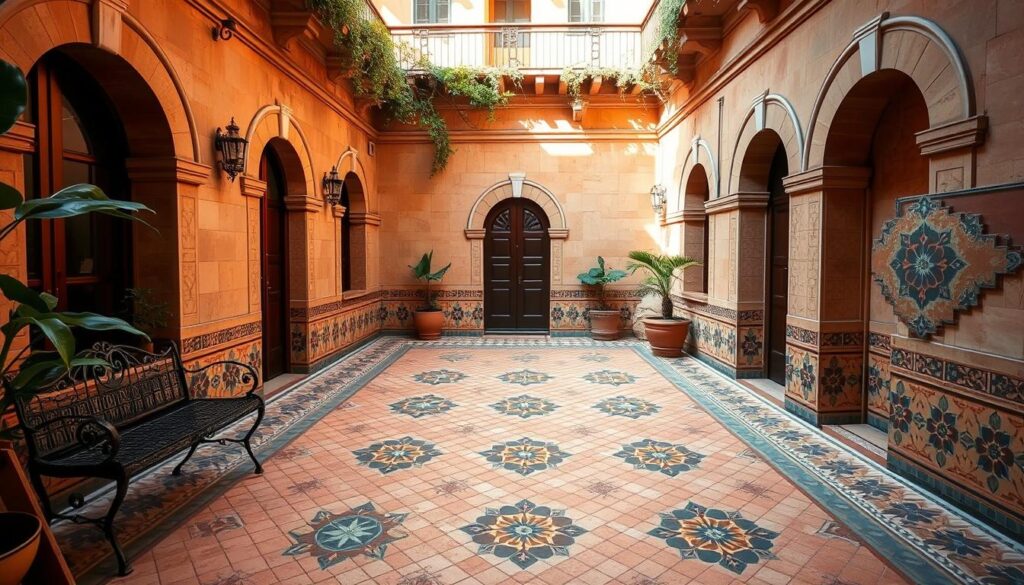
Blending Old and New Aesthetics
Mixing old and new needs careful thought. Using Spanish tile patterns with modern furniture creates a striking space. A vintage tile can be a focal point in a kitchen or bathroom, while modern appliances meet our needs.
Design experts say the key is finding common ground between styles. Choose modern pieces that match traditional Spanish design’s colors, textures, or patterns.
“The art of combining different styles lies in creating a harmonious balance that respects the essence of each.”
Tips for a Cohesive Look
For a cohesive Spanish-style home with modern touches, follow these tips:
- Choose a color palette that ties traditional Spanish color schemes with modern elements.
- Use traditional materials and craftsmanship, like handmade tiles or wooden beams, for authenticity.
- Match modern tech with traditional decor to keep the space balanced.
| Design Element | Traditional Spanish | Modern Addition |
|---|---|---|
| Tile Work | Intricate, handmade tiles | Modern, digitally printed tiles |
| Lighting | Wrought iron fixtures | Smart LED lighting systems |
| Furniture | Ornate, hand-carved pieces | Sleek, minimalist designs |
By carefully mixing modern convenience with traditional Spanish style, homeowners can create a welcoming space. This space honors the past while looking to the future.
The Role of Art in Spanish Interior Design
Art is key in Spanish interior design, adding warmth and character to homes. It makes Spanish-style interiors more beautiful and elegant.
Traditional and Contemporary Art Pieces
Spanish interior design mixes traditional and modern art, creating a unique look. Traditional art, like Spanish colonial pieces and religious art, adds history and depth.
Modern art, on the other hand, brings a fresh vibe. It lets homeowners make their space their own. The goal is to find a balance between old and new, making sure the art fits the design.
Choosing Art to Complement Your Home
Choosing the right art is vital in interior decorating. The art should match the homeowner’s style and the home’s architecture.
In Spanish-style homes, art that fits the warm, welcoming vibe is best. Look for pieces with earthy tones, vibrant colors, and Spanish culture themes.
Gallery Walls and Their Impact
Gallery walls are a hit in Spanish interior design. They let you show off a collection of art, making a room’s focal point.
A well-chosen gallery wall adds interest, depth, and personality. It’s a flexible way to add art to your decor, mixing different styles and pieces.
Personalizing Your Space with Spanish Elements
Adding Spanish touches to your home is more than just making it look good. It’s about making it truly yours. Spanish interior design emphasizes personal touches to make your home special.
Finding Authentic Decor Items
To bring Spanish style into your home, look for real decor items. These can be handmade ceramics, carved wooden furniture, or colorful textiles. You can find these at local markets or online stores.
For example, a Spanish-style vase can add elegance to your living room. These items not only look great but also tell stories of tradition and skill.
“The right decor can transform a house into a home, making it a reflection of one’s personality and style.” – Interior Design Expert
Using Family Heirlooms in Design
Family heirlooms are key in making your Spanish-style home personal. Using items passed down or with sentimental value adds warmth and character. Display antique furniture, vintage clothes, or other special items to enhance your design.
An old wooden chest can become a coffee table or storage, adding history and function to your space.
Tips for a Unique Touch
To make your Spanish-style home stand out, mix old and new. Here are some tips:
- Pair vintage and modern furniture for an interesting look.
- Use bold colors or patterns on walls or accessories for a personal touch.
- Add personal mementos or travel souvenirs to tell your story.
For more ideas on Spanish-style interiors, check out our guide.
| Decor Element | Traditional Spanish Style | Modern Twist |
|---|---|---|
| Tile Work | Intricate mosaic patterns | Geometric patterns with bold colors |
| Furniture | Ornate, hand-carved wood | Sleek, minimalist designs with wooden accents |
| Textiles | Vibrant, patterned fabrics | Neutral tones with subtle texture |
Mixing traditional Spanish elements with personal touches makes your home beautiful and personal. Whether through authentic decor, family heirlooms, or modern twists, your space should reflect your unique style and story.
Final Thoughts on Embracing Spanish Style
Spanish-style interior design is a mix of warmth, elegance, and rustic charm. It combines elements of Spanish architecture and rustic decor. This creates a welcoming and sophisticated space.
Practical Takeaways
To bring Spanish style into your home, use earthy tones and rich textures. Add statement pieces like handcrafted furniture and decorative tile work. Mix modern convenience with traditional elements for a timeless and functional look.
Finding Inspiration
Looking for more Spanish-style design inspiration? Check out architectural salvage yards and online design platforms. They offer endless ways to find inspiration and guidance for your design journey.
Our Design Commitment
We’re dedicated to helping homeowners reach their design goals. Whether you want a fully Spanish-style home or just a few key elements, we’re here to support you.

